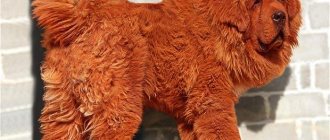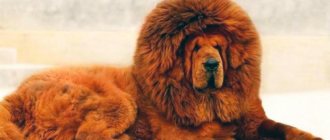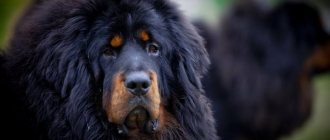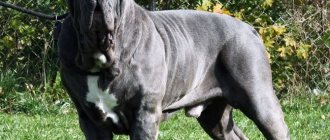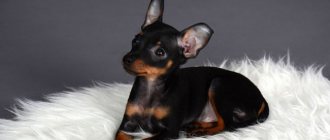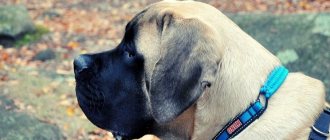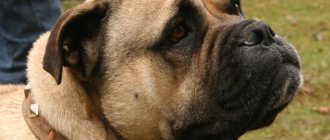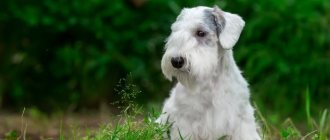Before you get a four-legged pet, you need to carefully study all the characteristics and features of the breed you are interested in. This is extremely important, since dogs have individual characters, sizes, habits, temperaments, preferences and much more. In our article we will talk about the Tibetan Mastiff breed, photos and pictures of which you can see below. This species belongs to the most ancient representatives of watchdogs and was used as an assistant in the protection of monasteries in Tibet and Nepal, and acted as a protector of nomadic families and their livestock from unwanted guests.
Origin story
There is no exact historical data regarding the origin of one of the largest dogs in the world - the Tibetan mastiff. Sources vary greatly in information and facts about the appearance of the breed, and are also embellished with various legends and myths. Some information says that their ancestors are black Himalayan wolves, while others claim that the genus of the Tibetan mastiff came from the guard dogs of Chinese traders who plied the mountains of Tibet. It is known for certain that the first written mentions of shaggy giants date back to 1121 BC. An entry in the Chinese chronicle Shu King says that mastiffs protected the homes of monks, temples and herds of domestic animals from the attacks of predatory snow leopards and from other, no less aggressive inhabitants of the mountains.
Myths and legends, as well as beautiful traditions, say that the first dogs of Tibet belonged to the Buddha himself and the brave Genghis Khan. Dog experts hypothesize that purebred varieties of Tibetan mastiffs are the ancestors of all current breeds of four-legged molossoid species, which includes such famous dogs as St. Bernards, shepherd dogs, Rottweilers, boxers, Great Danes, etc.
The first European notes about the shaggy giant were recorded in 1847. This year, the shaggy puppy was presented as a gift to the English monarch, Queen Victoria. Documented standards for the Tibetan Mastiff breed were recorded in writing in Europe by the Berlin Zoo only in 1898.
Representatives of this species are quite rare and expensive pets. Their value is due to the fact that they were able to preserve their appearance and characteristics almost in their original form. The inaccessible Himalayan mountain range protected the breed from external influence from the southern border, and from the northern border this function was performed by the desert. This contributed to the fact that the appearance of the animals remained original, unchanged and impressive.
About the breed
The Tibetan Mastiff is a very large and strong dog with a well-developed muscular physique. Its peculiarity is a long and thick coat with abundant thick undercoat, which creates a kind of mane in the neck and forearm area. This trait gives the breed an amazing resemblance to lions; the animal looks menacing and angry. The dogs are very hardy, they tolerate both cold and hot days well, thanks to which they can safely live outside all year round. The weight of an adult individual ranges from 59 to 85 kg, reaching a height at the withers of 61 – 78 cm.
The characteristics of the Tibetan Mastiff allow it to be used as a companion, guard or even bodyguard. The dogs are smart and well trained, friendly and incredibly loyal to their owner. True, the animal will be able to perform its functions 100% only after reaching adulthood, for boys this is 2-3 years, girls mature only at 4 years. This species has excellent sexual characteristics - males are much larger than females.
Dog character
The Tibetan Mastiff's personality has been described as balanced, calm, gentle, friendly and patient. But this is inherent to him only if there are no irritants from outside. When the owner, family or home is threatened, the ability to make decisions, quick reactions and aggression are manifested. The Great Dane perfectly protects the territory entrusted to him and his household from any danger. The breed is one of the highly intelligent representatives of four-legged pets, this is a consequence of the fact that in Tibetan houses it was normal to leave the mastiff in charge of the elder, children and livestock were entrusted to them, the dog itself monitored the maintenance of order.
Dogs of this species perfectly understand their own self and are independent family members who require equal treatment and can sometimes refuse to obey. Along with this, they are very reserved and loyal, they get along well with other dogs and cats, if they are peaceful and do not show arrogance and anger. Tibetan Mastiffs are very warm towards children and can easily become excellent nannies. They are tolerant and perfectly understand their size: if a dog plays with a small child or a person with disabilities, then it will never make awkward movements that could cause injury.
If the pet is used exclusively for security purposes, then it is important to understand that its activity occurs more at night; during the day, shaggy household members are most often drowsy and inactive. It doesn’t have any negative characteristics as such, but everything is individual.
Breed standards
The standards of the Tibetan Mastiff are characterized by many breed indicators and descriptions, these are not only the correct proportions of the body and general appearance, but also temperamental characteristics, color, size and weight.
The main characteristics that define the breed:
- The head is massive, weighty and strong with a large skull, with folds from the tips of the eyes to the edges of the mouth. The frontal part is wide, a tubercle on the back of the head can be easily felt;
- Muzzle with a square end and a blunt edge;
- Powerful jaws with a perfect scissor bite and well-defined lips that completely cover the lower row of teeth;
- The eyes are dark brown, medium-sized, oval-shaped, widely spaced closer to the edges of the head;
- The ears are hanging, medium in size, triangle shaped, slightly covered with soft down. In case of anxiety, they rise;
- The neck has an arched shape, strong structure, with a small dewlap. It is characterized by a long and dense mane-like coat;
- The back is level, the body is large with a well-developed muscular system and a wide, egg-shaped chest;
- The tail is of medium size, lush, smoothly transitions from the dorsal line, has a right or left curl with a beautiful long pile;
- The paws are proportional to the body, massive, and have a regular, even shape.
Weight by month
As mentioned above, in the description of the Tibetan Mastiff breed, dogs do not mature quickly and reach maturity only by 3–4 years. Newborn puppies are born bald with a weight of 400-500 grams, then in the first month of life they gain up to 5 kg and continue at this rate right up to the fourth month, respectively 11 kg for the second month, 15-16 kg for the third and 17-18 kg. fourth. Then there is a weight jump of as much as 7-8 kg and at 5 months the Tibetan Mastiff puppy already weighs 24-25 kg. Over the next seven months, the baby adds 3-4 kg to his body weight and by the age of one year he already weighs 41-44 kg. Every six months following, the four-legged miracle increases by another 5 kg and at two years of age reaches 53-54 kg, respectively. Depending on the feeding ration, each subsequent year the dog gains another 3-4.5 kg and at the peak of its development weighs about 60 kg.
Maximum height and weight
Some specimens of an adult Tibetan mastiff can reach a weight of 88-90 kg and have a height at the withers of up to 80-85 cm.
The largest and most expensive
The Tibetan Mastiff breed is one of the largest in the world and its largest representative, as well as the most famous and expensive, is a male named Big Splash, originally from China. His weight is truly impressive and equals 113 kg. This red baby at 11 months of age already weighed as much as 80 kg. He is also the most valuable dog on the planet and cost his owner $1.5 million. The diet of this pet includes the best varieties of chicken and beef meat, as well as exclusive seafood, which pays off handsomely, since mating with this giant costs more than 15 thousand dollars and the queue for it is impressive.
Appearance from photo
As stated above, this is a huge and muscular breed. Pupils of the Tibetan Mastiff, whose height at the withers reaches 68-78 cm, have a luxurious, voluminous, thick coat with a warm undercoat, which can be seen in the photographs and pictures below.
Coat type and color
The coat of this type of mastiff is unique in its appearance and composition - an abundant elongated pile with a very thick undercoat allows the animals to feel good in the harshest winter conditions, they sleep peacefully in the snow and tolerate icy mountain winds well. As described above, in the neck area the hair has a special length and visually resembles the mane of a lion.
The color of Tibetans is varied and is represented by the following options:
- Black;
- Ginger;
- Brown with iridescence;
- Golden;
- Red;
- Fiery;
- Fiery red;
- Red-orange;
- Chestnut, different shades of gray and blue.
There may also be combined colors with tan inserts in the eye area, on the tip of the tail and all paws.
Is there such a thing as white?
A very rare occurrence is the birth of a white mastiff puppy, which you can see in the photo below. Due to the enormous difficulty of breeding this color, white color is not accepted as a standard. The white Tibetan is a very expensive dog, it looks gorgeous, its cost is estimated at 1 million dollars or more.
Choosing a puppy, price range
As we have already noted, the Tibetan Mastiff dog breed is rare, not very common in purebred form, but has many fakes in the form of crossbreeds. To avoid deception and not get an angry and huge dog, contact only nurseries and breeders with permission from the RKF to breed mastiffs.
The choice of a puppy itself is not difficult and is not much different from choosing puppies among other breeds. Availability of all documents, comfortable living conditions, healthy bitch, provision of all documents for puppies and subsequent patronage - these are the key conditions for choosing a puppy from a particular breeder. The puppies themselves are large, should have a healthy appearance and dense, soft fur without bald spots. Must show affection and lack of aggression.
Prices for pet-class puppies start at 50,000 rubles; for a show class, expect 60,000-150,000 rubles, and the price of a breeding class can reach 400,000 rubles.
IMPORTANT: require breeders to provide documents for mating; the admixture of foreign breeds can result in the dog’s uncontrollable aggression.
Proper care and maintenance
Caring for furry babies and big giants is no different from caring for standard dogs, but requires some nuances, which will be discussed. You can keep such red babies nearby both indoors and outdoors, but the second option is most preferable.
Shedding
Tibetan mastiffs do not shed frequently; this phenomenon occurs once every 365 days. In some natural zones, molting is completely absent. But when the shedding period begins, the hair falls out in clumps, which is a feature of the breed. Despite this, caring for your pet’s fur is quite simple. Caring for them can be compared to caring for shaggy German Shepherds. You only need to comb the soft undercoat a couple of times a week and give vitamins for the lint. As soon as the shedding has passed, fur care is reduced to once every seven days.
Basic moments
- This breed is not recommended for novice dog breeders: it requires competent socialization and incredible patience.
- The impressive size of the Tibetan is not always compatible with the usual apartments, so it is best to keep the dog in a private house.
- The peak activity of mastiffs occurs in the evening or even at night: this is when it is best to walk your pet outside.
- Tibetan Mastiffs cannot be kept on a chain because they are very sociable and want to spend time with their owner.
- These dogs are incredibly smart and independent, and in some cases you will have to show strength of character.
- All Tibetans have loud barks, so make sure your dog doesn't make noise for no reason.
- Mastiffs need constant physical activity, otherwise they can get bored and literally turn your house into ruins.
- They do not like noisy companies because they see them as a potential threat.
- They get along well with children and, under certain circumstances, animals.
The Tibetan Mastiff is rightfully considered the property of a mysterious corner of the globe - the “roof of the world” called Tibet. Representatives of this breed are known as reliable and fearless protectors who do not lack self-esteem and an independent character. Looking at the dog’s menacing appearance, it’s hard to imagine that this breed is one of the friendliest and most loyal. The centuries-old duet of man and mastiff taught the latter to show remarkable patience and understanding.
Breeding: heat, how many puppies does she give birth to?
The first menstrual cycle in a female dog occurs at eight months of age and is repeated once a year, most often in late autumn. The animal's immunity weakens, and it requires special attention and care: the fur should not be allowed to get wet and hypothermia. The first mating can be done only at more than two years of age. The gestation period usually lasts between 54 and 66 days. At this time, the dog is especially aggressive and only allows its owners to approach it. Childbirth is slow. In one litter, the bitch produces offspring of 5-12 cubs, which are born almost bald.
How to care
To keep your dog healthy and happy, he will need standard canine care.
First of all - combing. The animal is large, has a lot of wool, and sheds every year for two weeks in spring and autumn. You need to comb it first with a slicker brush, then with a regular comb, then with a massage brush. The resulting fluff makes excellent thread, and scarves and sweaters made from dog hair are popular.
A big plus for Tibetans is that they do not smell like dogs and their fur is designed in such a way that it hardly gets tangled.
It is not recommended to cut them; you can disrupt the hair structure and end up with a dog with split ends or problems with thermoregulation.
The remaining procedures are not so labor-intensive:
- Bathing. Any animal gets dirty on the street, this is normal. If the dirt is small, simply wipe it off with a wet cloth. If the dog gets all dirty, he is either driven into the bathtub or sprayed with dry shampoo and combed out. The procedure cannot be carried out too often, otherwise the production of fatty secretions will be disrupted.
- Nail trimming. Every two weeks they are cut with a sharp nail clipper of a suitable size, and then polished with a nail file.
- Dental treatment. They are cleaned every two days with a soft brush.
- Ear cleaning. The ears are drooping, so they are examined carefully every two days. If the ear is pink and clean, everything is fine. If dirt has accumulated in it, wipe it off with a cotton pad or napkin. If an unpleasant odor, swelling or fluid appears, the animal is taken to the veterinarian.
- Eyes. Despite their good shape, a little discharge still accumulates in them in the morning. They are washed with a damp cotton pad.
The pet is accustomed to all procedures while it is still very small. Considering the size of an adult dog, it will be impossible to force him or hold him against his will unless anesthesia is used.
And, of course, you will need daily walks. Four hours a day if the dog lives in an apartment, two or three if in an outdoor enclosure. Walk actively, play, run, communicate with other dog lovers. Harness it to a sled in winter, and harness it to a cart in summer.
Can you keep it on a chain?
Under no circumstances should this breed be kept on a leash. Constant keeping in an enclosure is also contraindicated; it should be closed there only when absolutely necessary, when strangers are in the house. The cage for the Tibetan Mastiff is made spacious and strong; it is not recommended to install a thin wire mesh or chain link.
If a Tibetan dog is left to roam in the yard, the fencing system should be of an appropriate height.
Tibetan Mastiff - conditions of detention
Large breeds need an area to roam. A private home is best suited for them, and in the case of apartment housing, you will have to take your pet outside 3-4 times a day for at least 30-40 minutes. The peculiarities of keeping a Tibetan mastiff are associated with the huge size of the animal and the presence of thick hair. It should be borne in mind that dogs do not have sweat glands, so in the heat it is important for them to have shade, or at best, coolness.
Tibetan Mastiff - keeping in an apartment
If you want to become the owner of this large dog, then you can keep him in an apartment, although this is not considered an ideal option. A Tibetan Mastiff can live in an apartment if there is enough room space.
- The dog should have room to sleep comfortably in a position that suits him.
- In addition, there must be a place for the pet in all rooms so that it can sit next to its owner.
- To keep a Tibetan mastiff in an apartment, the characteristics of the breed show that a place for feeding must be allocated in the kitchen or other place so that the animal can stand upright and be comfortable.
Keeping a Tibetan Mastiff in a private home
Many people living outside the city choose large breeds, and if you plan to keep your pet outside, you will have to build an enclosure. If you are wondering whether it is possible to keep a Tibetan Mastiff on a chain, then the answer is no, since the dog is territorial and must run around the area. When organizing an enclosure, consider the following features:
- The size of the enclosure is at least 2x3 m and 2 m in height. It should be divided: 1/3 part - a booth and a bed, where the floor should be covered with boards, and there should be a canopy on top, and 2/3 parts should be sown with grass or covered with sand.
- The rest area should not be filled with concrete. A roof over the resting place must be provided to protect the animal from overheating and rain.
- Even when kept in an enclosure, the pet needs daily walks.
Tibetan Mastiff as a guard
Since the ancestors of this breed are shepherds and guards, the characteristics of the mastiff breed indicate that they are ideal guards. By their very appearance they evoke respect from others, so many will be afraid to simply approach the house. The main protective qualities of the Tibetan Mastiff: fearlessness, absence of causeless aggression, self-sufficiency and determination. In addition, dogs of this breed have characteristics such as endurance, strength, and they also have a good sense of their territory and will warn about uninvited guests.
How many times should I wash and comb?
Bathing procedures for the Tibetan Mastiff should be carried out as needed, but it is recommended at least once a quarter. This is explained by the fact that despite the dense wool, household members of this breed practically do not have any unpleasant odor. After washing, the animal must be combed and dried with a hairdryer, the air flow of which must be directed against the growth of the pile. This is necessary in order to achieve maximum fur fluffiness. Tibetans are combed one to three times a week, depending on the condition of the coat.
How to cut your hair?
There are no special features of the haircut process. A hygienic haircut is desirable, but not required. It is needed when there are fur tangles in the wool that cannot be sorted out or combed out. Decorative or seasonal haircuts are carried out solely at the discretion of the owners. The only requirement is not to cut the hair too short, as the animal may catch a cold and get pneumonia. Ideas for haircuts for Tibetan dogs can be found in photos in pet catalogs or animal hairdressing salons.
Photo and video review
The Mastiff is a dog with a strong character, self-sufficient, balanced and friendly. To achieve success in raising a pet, you need to devote more time to the dog, treat it with respect, and often take walks in the fresh air. The dog loves freedom and independence and needs outdoor games. Below is a photo and video of the mountain giant.
Training and education
Tibetan Mastiffs and humans get along well, but the breed is sometimes difficult to train at home. Expert breeders recommend sending puppies to canine centers to undergo an obedience course. Training begins with mastering simple commands, such as “Ugh!”, “Lie down!”, “Come to me!”, “Near!” etc. In the first year of life, skills are trained according to commands, and in subsequent years they are consolidated and endurance is developed.
A Tibetan is a student who requires respectful treatment, and not just giving commands. First of all, he is a friend, not a servant, and it is important to understand this.
Health and life expectancy
Shaggy fire giants are naturally endowed with excellent health and long life. The average lifespan of a four-legged pet ranges from 13-15 years, but there are also long-livers, albeit under proper living conditions. Due to their large size, dogs are prone to ailments of the paw joints, so an annual X-ray examination is recommended.
Diseases of the breed
As mentioned above, animals of this breed are distinguished by endurance and good health, but still, like all living beings, they are characterized by some diseases:
- Dysplasia of the pelvic and hip joints;
- Allergic reactions;
- Diseases of weak bones and bone tissue;
- Malignant tumors;
- Dermatitis and osteochondritis;
- Rabies, plague and hepatitis of infectious origin.
Timely vaccination will avoid most illnesses and protect the giant’s immune system for many years.
Important! Systematically take your household member to the veterinary clinic for a routine medical examination and the doctor will always be able to identify early symptoms of disease and prescribe adequate and timely treatment.
Diet and feeding rules
In order for your four-legged friend to lead an active lifestyle and feel good, you need to properly organize his nutrition. This breed of dog is not at all picky about food and eats relatively little.
For purebred puppies, an excellent diet will be beef or horse meat, raw and boiled, heat-treated offal, vegetables, a variety of cereals, milk and fermented milk products (cheeses, kefir, cheese).
Adults are fed beef and veal, seafood, bird eggs and the same set of products that are used for puppies.
It is necessary to ensure that the animal always has clean water and food includes the required amount of vitamins and microelements. If you use food, then choose only trusted manufacturers and those that are specifically intended for the Tibetan Mastiff breed.
What to feed?
For the owner, a more convenient option for feeding his pet would be to use high-quality industrial food, which includes all the necessary substances to maintain the health of the animal. The owner of the nursery where you buy the puppy, or a good veterinarian, will advise you on which food is preferable.
If you choose natural products, you should definitely make your diet varied and consisting of high-quality ingredients.
- Meat . Low-fat varieties are desirable: veal, beef, chicken, turkey, rabbit.
- Cereals . The ideal option is rice. It was this that historically was the basis of nutrition for Tibetan mastiffs.
- Vegetables . You can use a variety of vegetables, excluding onions and potatoes. Give cabbage with caution.
- Dairy products . Diversify your diet with cottage cheese and kefir.
- Eggs. Use both chicken and quail eggs.
If your animal is on natural feeding, it is worth periodically giving a course of vitamins.
Breeders' advice for buying a puppy
Buying a puppy is a very serious step that needs to be approached with full responsibility. You need to choose a baby endowed with excellent physical health. If you don’t have any special wishes for external characteristics, then buy the fastest, most well-fed and strong puppy from the litter. It is important to understand that female individuals will be much smaller than male representatives. The color can be chosen from personal preferences; the color range is represented by a wide choice, from red to gray and even blue shades.
A Tibetan Mastiff puppy, endowed with all the attributes of the breed, must have thick and at the same time fluffy hair with an excellent layer of undercoat. The purchased baby must have clear and healthy eyes, with no signs of illness or disease.
Nicknames for boys and girls: what to call
The very name “Tibetan Mastiff” emanates oriental notes, and therefore nicknames with an oriental slant are more suitable for representatives of this breed. But still, the owner himself gives the name to his pet, relying entirely on his own discretion; there are no clear rules in this matter. For those who are scratching their heads and don’t know what to name their household, we have selected the following lists of names:
For boys: Weiming, Liu, Bingwei, Enlei, Guangli, Cheng, Rong, Zen, Bei, Xin, Kiang, Shining; For girls: Yanlin, Zhu, Ting, Lijuan, Luli, Yubi, Rou, Peizhi, Bo, Meili, Shihong, Tao, Bao, Chuntao.
List of nicknames
More often, Tibetan puppies are given Chinese nicknames. The names of male dogs symbolize power and strength. Girls are given softer – cheerful and cheerful nicknames.
Boys according to this principle can be called: Abramid (incredible), Cheng (powerful), Zian (good watchman). For girls, nicknames such as Lubsama (smart), Gunga (joyful), Xiu (loves children) are suitable.
Other nicknames for male dogs:
- Rider, Olympus, Akbar, Apollo;
- Nike, Kazbek, Badi, Rastley, Murphy;
- Caesar, Tucker, Oscar, Clyde;
- Bek, Horus, Rusty, Lucius, Polkan;
- Claude, Butch, Fred, Rudolph, Ray;
- Monty, Oton, Dustin, Stif, Luke;
- Diesel, Cooper, Scooby, Chase;
- Rex, Marcel, Troy, Ernie, Newman;
- Lloyd, Ringo, Adrian, Persian, Pulion, Titus, Frank.
Nicknames for girls:
- Jess, Fanny, Chasey, Piggy, Zlata;
- Cassie, Ulli, Emmy, Doxie, Ulma;
- Lucky, Rhonda, Chita, Ollie, Fiona;
- Sheldi, Alma, Zara, Tosya, Adele;
- Alice, Ada, Hera, Chessa, Gina;
- Dana, Helga, Diya, Zhulya, Gizma;
- Cessa, Lexi, Tracy, Abby, Viva, Strelka, Sophie.
How much does a puppy cost?
As mentioned above, puppies of the Tibetan Mastiff breed are today the highest paid dogs in the world and not everyone can afford to buy one. In each country, the price of a baby varies and depends on many indicators. So they are the most valuable in their homeland; in China, such a purebred miracle costs from 25 to 35 thousand dollars. The European price tag falls much lower and reaches 1-5 thousand dollars. The Russian price range ranges from 40-160 thousand rubles per crumb. In any country, breeders are willing to pay fabulous sums for a rare specimen. Thus, the most expensive exclusive Tibetan Mastiff puppies cost about 1.5 million dollars and more.
Conclusion
The Tibetan Mastiff was bred in China for protection. Later, thanks to the king of Nepal, the breed spread throughout European countries and America. For Russia, this mountain dog is a rarity, but is in great demand, which is why it is expensive (75-150 thousand rubles).
The Mastiff is in good health (especially girls), he is a born guard and is ready to constantly monitor his possessions. This dog is designed for a large area; it will be cramped in an apartment. Proper upbringing from puppyhood will make the Tibetan giant an obedient and friendly family member.
Owner reviews
Having studied the reviews of breeders and canine breeders of furry giants, it turned out that most of them are inclined to the following conclusions:
- Natives of the breed are characterized by excessive distrust of strangers and the absence of any aggression towards their family members;
- They are characterized by restraint, poise, high intelligence, calmness and the ability to protect the objects entrusted to them and their owners;
- The shaggy giant is moderately evil and uses aggression in exceptional situations;
- Such animals do not attack without certain reasons; they are quite friendly with children, as well as with other four-legged household members;
- They can become everyone's favorites in both small and large families.
No negative qualities have been noticed in these dogs, except perhaps excessive stubbornness, and this disappears with proper upbringing.
Interesting to know! The Tibetan Mastiff is not just a guard dog, it is a friend and a full-fledged family member who participates in all household chores and perfectly captures the mood of each member of the household.
Pros and cons of the breed
Advantages of the Tibetan Mastiff:
- immediately comes to the defense of its owner and other family members;
- does not require careful care;
- attractive appearance;
- with proper training, training is successful;
- sincerely loves and trusts his owner.
Disadvantages of the breed:
- excessively high cost of purebred puppies along with accompanying documentation;
- Difficulties arise during education and training;
- the dog cannot be kept in an apartment because it is too large;
- If you do not engage in socialization, then the pet will pose a danger to people.
